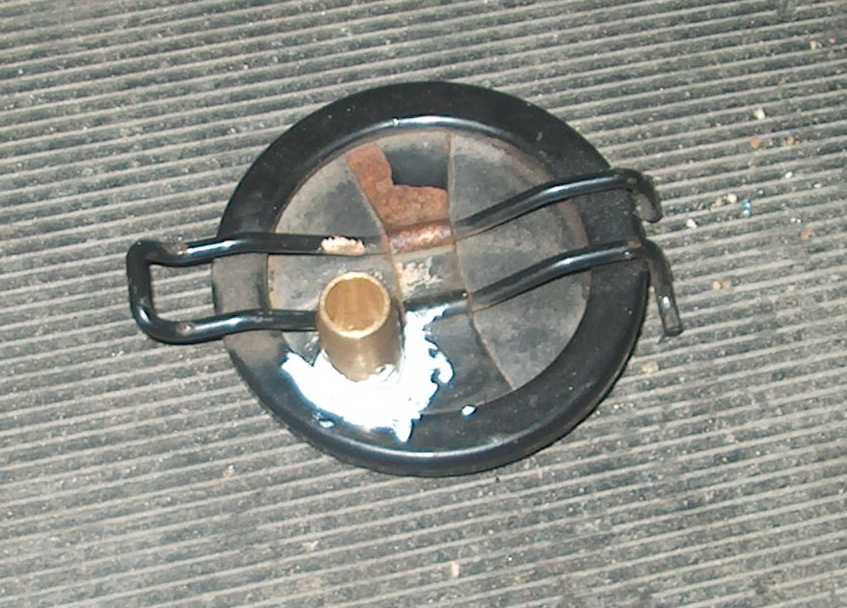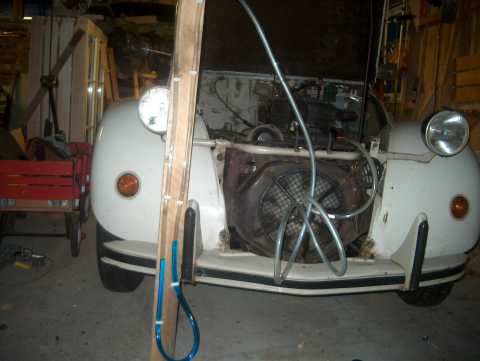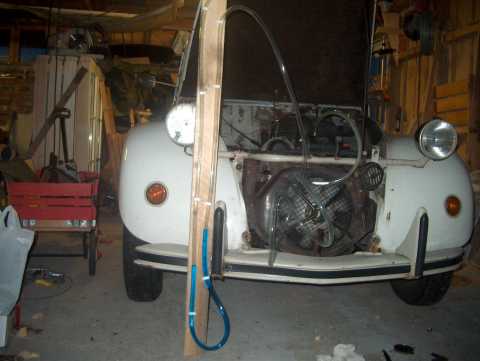

The opposed 602km twin humming happily along just in front of your tiny windscreen requires very little attention.
Occasionally, however, you will need to pay attention to the oily goo that appears at the various engine joints and shaft seals.
The oil astray is an indicator on a crankcase breather that may no longer function properly. The crankcase breather is responsible for establishing a sub - atmospheric pressure in side the crankcase. Like on the moon.
Link to a very good description of the breather (and an illustration of the breather itself)
A few words on my own experience with the breather:
Dusty did - after 135 000 km - fell a little out of breath. Negotiating an (upwards) hill involved breaking all sorts of speed limits at the bottom of it. Without neccesarily risking a speeding ticket at the top of the hill. Not sensational for a 2CV but still. . . Having a couple of 2CV's makes life a constant comparison, however. Dusty WAS lagging behind. We had observed a fair amount of goo around the engine block joints. And we had purchased a breather at the 2005 world meet in Kelso. May 2006, we replaced the breather and we could hardly recognize the lady, Dusty became a beast - a hilltop speeding patrol's best income source. Piloted by Hilde, that is. OK so we know the result. What is the story here?
Heure d'aller le docteur de les Coupe d'un reniflard
The mythbusting part involved first attempting to understand how the breather system works. There are several descriptions on the web referring to testing the under-pressure by connecting a U -tube to the oil dipstick pipe. And the idea that the vacuum at idle according to various sources (1, 2) should be at least 50-60mm water column.
So far so good. Why is the breather such a big deal ?
The 2CV boxer motor - or any 2 cylinder boxer for that sake - is
unique in a few respects - one detail is that the net crankcase volume
will vary by [602 ccm] once per revolution. This rapid volume surging is not present on
a four cylinder engine because on a four banger two pistons will be
exiting the crankcase when two are entering the same. For some of us,
adding two extra pistons just for the sake of constant crankcase volume
seems like a lot of hassle. In lieu of the surplus
pistons Walter Becchia
figured out that a
membrane based valve would offer the required pressure control.
Unless crancase vapor is allowed to exit, it is obvious that
crancase pressure would build up. The net
overpressure on the business side of the pistons will cause
combustion gas leak into the crankcase. It would therefore seem
like the breather system would be challenged as engine wear builds
up. However, with a reasonable valve, the vacuum pump action of the
flat twin should be quite decent.
In order for the hose - in - the - dipstick measurement to work decently, the permanent dipstick pipe must not extend to beneath the oil level in the crankcase. However, it would seem unlikely for a dipstick pipe NOT to extend below the oil level. In order to
MYTH -BURST the hose - in - the - dipstick theory; does the observed pressure in reality reflect the crankcase pressure, I made
an oil filler cap with a hose nipple attached to it.

And I tested the setup with plastic hose at the oil stick pipe

Testing pressure by connecting hose to dipstick tube - 5 cm pressure with new breather
and then from the custom built oil piller cap

Testing pressure by connecting hose to nipple on oil breather cap - 11 cm pressure with new breather
Verdict: is that the dipstick pressure measurement does not reflect the pressure in the crankcase. And on Lefty, the crankcase pressure with a new breather is 18cm. (tested on the cap). Lefty has 80,000 km on the odometer.
Updated by Terje Ellefsrod 10/21/06
In order for the hose - in - the - dipstick measurement to work decently, the permanent dipstick pipe must not extend to beneath the oil level in the crankcase. However, it would seem unlikely for a dipstick pipe NOT to extend below the oil level. In order to
MYTH -BURST the hose - in - the - dipstick theory; does the observed pressure in reality reflect the crankcase pressure, I made
an oil filler cap with a hose nipple attached to it.

And I tested the setup with plastic hose at the oil stick pipe

Testing pressure by connecting hose to dipstick tube - 5 cm pressure with new breather
and then from the custom built oil piller cap

Testing pressure by connecting hose to nipple on oil breather cap - 11 cm pressure with new breather
Verdict: is that the dipstick pressure measurement does not reflect the pressure in the crankcase. And on Lefty, the crankcase pressure with a new breather is 18cm. (tested on the cap). Lefty has 80,000 km on the odometer.
Updated by Terje Ellefsrod 10/21/06
